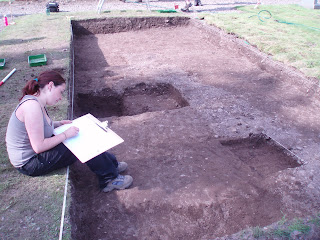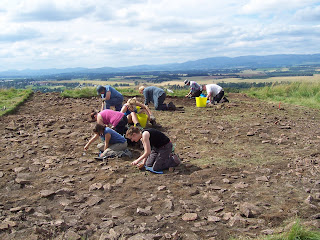Today has been a good and productive day in the tench of the Manse's backyard. Since the trench is located on the lawn of a private property, we try very hard to keep everything neat and tidy using loads of plastic and planks.
Yesterday we had uncovered a stone feature in the southern side of the trench. It consisted of stones and boulders and was running all along the edge of the trench, into which it disappeared. It didn't seem to be a wall because the stones were not neatly stacked and there was no distinctive facing. Geophysics and an 18th century map of the Manse's backyard show linear features, and on the map it appears to be a garden path.
To find out more about this feature, it was decided today to extend the trench south. That meant more deturfing and more mattocking, until we reached the level in which the stone feature was standing.
Although we have uncovered numerous finds, none of them are really remarkable. Most of it is modern material, consisting of pieces of pottery, glass and coal. Among the more interesting finds are an iron knife (with missing handle) and some herbivore molars, possibly sheep.
When the other side of the feature was uncovered, it became clear that this could not have been a paved pathway, it is too narrow for that. After we uncovered more, we were surprised to see that the other (southern) side was very neatly stacked and had a clear facing.
 |
| Close up of the wall, showing the north side on the right. The south side is obviously much neater and has a clear facing. |
 |
View of the trench with stone feature, the modern Manse in the background. On the left there is Robbie, a retired topographical surveyor that volunteers for the SERF project, and to the right Eva Hopman (author of this blog entry).
|
It's possible that the feature might have been an 18th century retaining garden wall with a path leading next to it. The loose boulders and stones on the northern side of the wall could have allowed better drainage into the garden soil. For now though, this feature is as good as any! We will uncover more of the wall in the next days and hopefully find out exactly what it's function was.
Written by Eva Hopman, 22 year old intern at the Archaeology department of Glasgow University















